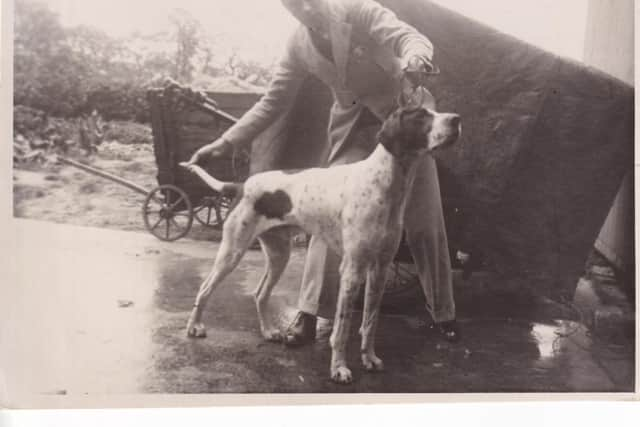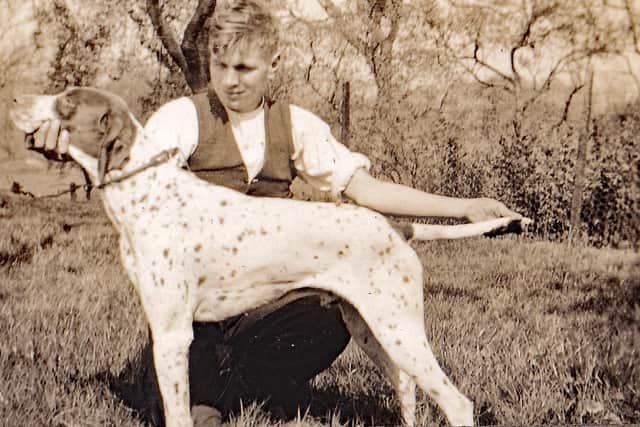When UK's best dog was born and bred in Lancashire
and live on Freeview channel 276
Certain activities associated with the north are seen as stereotypical, and often involve animals: pigeon and greyhound racing for fun and gambling, whippets and hawks as pets. And showing off your pets in competition was also notably northern, writes John Grimbaldeston.
Though the local agricultural shows do try to keep such traditions alive, the well-trained dogs there are now more usually on display in the main arenas, and the pets in informal competitions showing off their obedience, or lack of it, are mostly cute and comic crowd pleasers.
Advertisement
Hide AdAdvertisement
Hide AdSome dog shows still are serious competitions, but there are not so many local ones now as there were in the 1930s, and once Barton, north of Preston, had a national champion.


He lived at Raven Lodge, Station Lane, Barton, and was a Pointer which went by a name which hardly tripped off the tongue, Maesydd Meteor
Preston accents struggled with the Welsh, so those who bothered usually settled on ‘Maisy Sid’ when using his Sunday name, but he was ‘Tor’ to his owners and friends.
The Maesydd Kennel was founded in the 1930s by a gentleman called David Steadman, originally from Appleby, in Cumbria,but who moved to Machynlleth in Powys, Wales, on his marriage.
Advertisement
Hide AdAdvertisement
Hide AdHe bred English Setters and coursing greyhounds as well as pointers, and one of his greyhounds, Maesydd Michael, won the famous Waterloo Cup coursing event in 1946.


Traditionally the event held on Lord Derby’s estate in West Lancashire was one of the biggest events in the country calendar attracting 10,000s of supporters from across Britain and Ireland, rivalling the Grand National in popularity.
Maesydd Meteor was related to the 1932 Crufts’ Champion, Champion Flagon of Ardagh. Pointers were popular because of their hunting ability, and their “heart”, their desire to please in the way they worked.
Like other breeds such as Airedales, they were more common in the 1930s than they are today. Maesydd Meteor was competing between 1933 and 1935. He was the property of H W (Bill) Sykes and Mrs Sykes, Edith.
Advertisement
Hide AdAdvertisement
Hide AdMr Sykes was the son of Joe Sykes of Market Street, Preston, described as a corn, hay, straw and potato merchant in the 1917 Preston directory. Bill followed him into the business, but increasingly specialised in potatoes, and his name is still remembered well in Pilling, where farmers have long memories.
Mrs Sykes was the daughter of Charles White, co-owner of Enderby and White’s, a prestigious draper’s shop on Friargate, Preston, for many years until its doors closed around 1937.
Their status within the local business world gave them elevated status in Barton, and Mrs Sykes was occasionally called upon to open fetes and crown Rose Queens.
Captain Clifford of Ormerod House, Little Eccleston, also had an interest and also showed gundogs. Between them, besides Tor, they owned Tor’s sister, Maesydd Mystic, another champion Pointer, and two further frequent local prize winners, Cilfo Sunshine and Cilfo Sunway.
Advertisement
Hide AdAdvertisement
Hide AdThey were members of Blackpool Canine Society, and Captain Clifford was a leading light in the local poultry world as well, specialising in white wyandottes chickens.
Preston also had a canine society as well as Blackpool, and as has been noted, clubs and competitions were much more common than they are today, even in the smaller villages of the Fylde.
Tor, though, was on the national stage. He won many prizes around the northern circuit of dog shows, including Carlisle, Wharfdale, Blackpool and Southport.
However, the undoubted highlight of his career was arrived at the Birmingham Dog Show, a National Competition on a par with Crufts as far as sporting dogs are concerned, in 1933.
Advertisement
Hide AdAdvertisement
Hide AdAn article in the Lancashire Daily Post of June 1935 proudly proclaimed that year’s triumphs under the headline, ‘Barton Dogs Successes’.
It read, ‘Judged the best exhibit in the show, a pointer dog, Maesydd Meteor, owned by Mr HW Sykes of Raven Lodge, Barton, was awarded seven first prizes, six specials and six cups at the Rotherham Open Dog Show last weekend. Maesydd Meteor is having a very successful season. He has figured at six championship shows and has already gained six challenge certificates.’
The dogs were coached in presenting themselves at shows, a straight tail was paramount. The success of the two pointers in particular was put down to the long walks in the Fylde countryside but perhaps the real secret ingredient was the swimming sessions in the nearby Lancaster Canal which apparently gave them deeper chests and stronger front legs.
Maesydds Tor and Mystic were sold to America in the mid-1930s for stud purposes, to Leo A Dunn, a breeder who is in the American Pointer Club Hall of Fame.
Advertisement
Hide AdAdvertisement
Hide AdHe incorporated them into his Elstone line of thoroughbred pointers, so in a way, Barton’s own champion lives on yet.
Moments in Time, Glimpses of a Lancashire Village by John Grimbaldeston is available priced £25 from [email protected]